One of the biggest pains of moving is figuring out how to move all of those clothes in your closets and drawers from one place to another.
The main issues of moving clothes are, of course, how to pack your clothes without getting wrinkles, how to make sure they stay clean, and how to keep your clothes organized when moving. This might be a big enough hassle for some people to drive them to consider having Ottawa movers like us do it for them!
But there are ways to pack your own clothes if you’re willing to take the effort. Here are some tips and advice from our knowledgeable Pembroke movers that will help you make sure that your clothes packing goes as smoothly as possible during your move.

Free Ultimate Moving Checklist
Say goodbye to moving stress with our 2023 residential moving checklist for Canada—it’s the ultimate time-saver!
Download NowA. Choose What Clothes to Take With You
If you want to know the secret to how to keep your clothes organized when moving, simply sort your clothes properly well before the big day. This can save you time, money and prevent you from pulling out your hair when it comes to unpacking and discovering you don’t know where a particular item of clothing is.
How do you sort clothing?
1. Don’t Pack Clothes You Don’t Need
First, get rid of the following items:
- Clothes you won’t need if you’re moving to a different climate or from the country to the city (and vice-versa).
- Clothes that are out of fashion.
- Clothes that you or your children have outgrown.
- Clothes that are worn out or torn.
- Clothes that don’t suit your style and that you never wear.
What do you do with this excess?
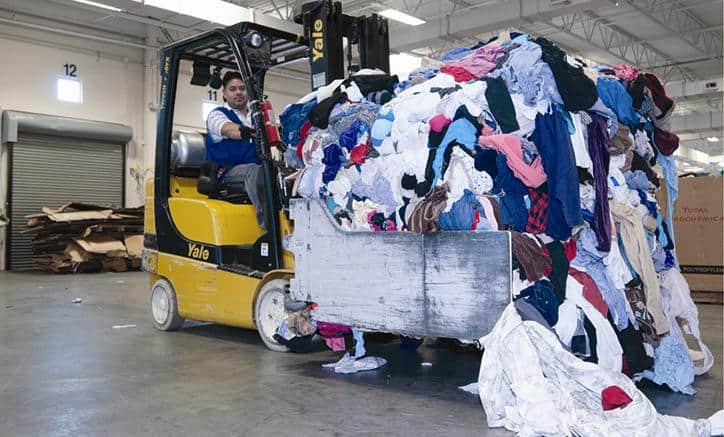
- Sell it at a garage sale (but only if your profit will be worth the time and energy, and you want to do the work), online, or to vintage shops.
- Donate it to charity if it still looks appealing and isn’t junk.
- Bring them to a textile recycling center, especially if the clothes are ripped or damaged. (You might want to keep some of these clothes for the time being, however, if you’re using them to wrap other items during the move. More on this later.)
2. Choose Clothes to Wear During the Move
Put aside what you will wear on the day you move in your moving day personal kit. These clothes should be comfortable and take into account the weather. Have clothes on hand for when the weather unexpectedly changes, such as if it starts raining.
Also put aside some towels, underwear and pajamas for showering and resting in your new home on the first night. It might take a day or two for your stuff to be actually moved, so also have an additional change of clothes on hand. Start building your duffel bags now and add to them as you continue to pack.
3. Pack Clean & Dry Clothes
Yes, we know you already have enough laundry on your hands. Making sure the clothes that you are packing into vacuum bags and boxes are clean and dry. This will prevent any smell from forming. It’s easy for clothes to get musty from sitting too long.
No matter how noble your intentions, it will take longer to unpack than you think! Adding a single, unused dryer sheet to a vacuum bag of clothes will also mean a nice-smelling, fresh set of clean clothes or sheets when you unpack.
4. Double Box your Moving Boxes
Clothes get heavy quickly, as light as they may seem. We recommend using small or medium moving boxes to prevent lifting heavy boxes on moving day. However, if you must use a large moving box, be sure to double it up and double tape the bottom. You don’t want your box ripping and your clothes spread all over the street!
B. Group Your Clothes for the Move
This will help your packing go smoothly and you’ll be able to find specific clothes you may need after the move. It’ll also help you know how to pack your clothes without them getting wrinkled. If this is too much work, you can skip all this and just pack the way you would if you’re in a hurry but packing clothes in an organized way will make your move smoother.
Be sure to sort items by:
- Material. Natural and cotton fabrics can crease and you may have to iron them after the move. If you don’t want them to get creased, place them on hangers and put a clothing bag over top. Meanwhile, woollen clothes take up more space and may need a few extra boxes. Polyester and synthetic clothes can be stuffed into boxes without issue as they don’t crease easily. Fold them as you would any other clothes and place them one on top of the other.
- Season. This will help you find and unpack all of the clothes you might need right away and help you ignore unpacking seasonal clothing- such as summer clothes when it’s snowing outside or winter coats during a heatwave.
- Size. Small items can go into one box and longer clothes are best packed together. Just be sure to carefully label items if you’re mixing and matching them in a box. Fold clothes using the military rolling method and compression bags or vacuum bags to condense clothing items and protect them better than trash bags. Non-hanging clothes can be packed in a duffel bag, or cardboard box; hanging clothes should be packed in garment bags and wardrobe boxes.
- Need. If you want to find comfortable clothes right away, having them packed aside from more formal clothing you won’t need right off the bat will help you easily find them. You can actually start doing this well before your move to save time and hassle. Items like your wedding dress or items of sentimental or monetary value that you only need for special occasions can be packed into wardrobe boxes or cardboard boxes and garment bags.
C. Pack Your Clothes
There are a few tricks you can use to pack your clothes without wrinkles and keep them organized when moving:
1. Don’t Empty the Dresser — Move It As Is
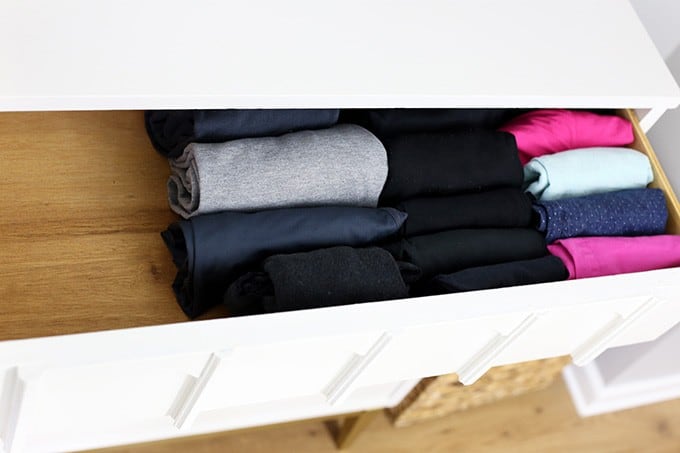
If you have lighter items in your dresser drawers, such as socks and underwear, you might be able to move them without emptying them. Check with us (or whatever professional Stittsville moving company you use) first to make sure it is okay to move the dresser with contents in it.
One idea, if you can move the dresser with items in it, is to put clean sheets, towels and pajamas in each drawer so you know where they are when you get to your new home. This will also help save space in the truck and cut down on all the clothes and moving boxes.
Moving the dresser as is usually a good strategy if you’re just moving within the same city. Be sure to secure the dresser with stretch wrap.
2. Hang Clothes in Wardrobe Boxes
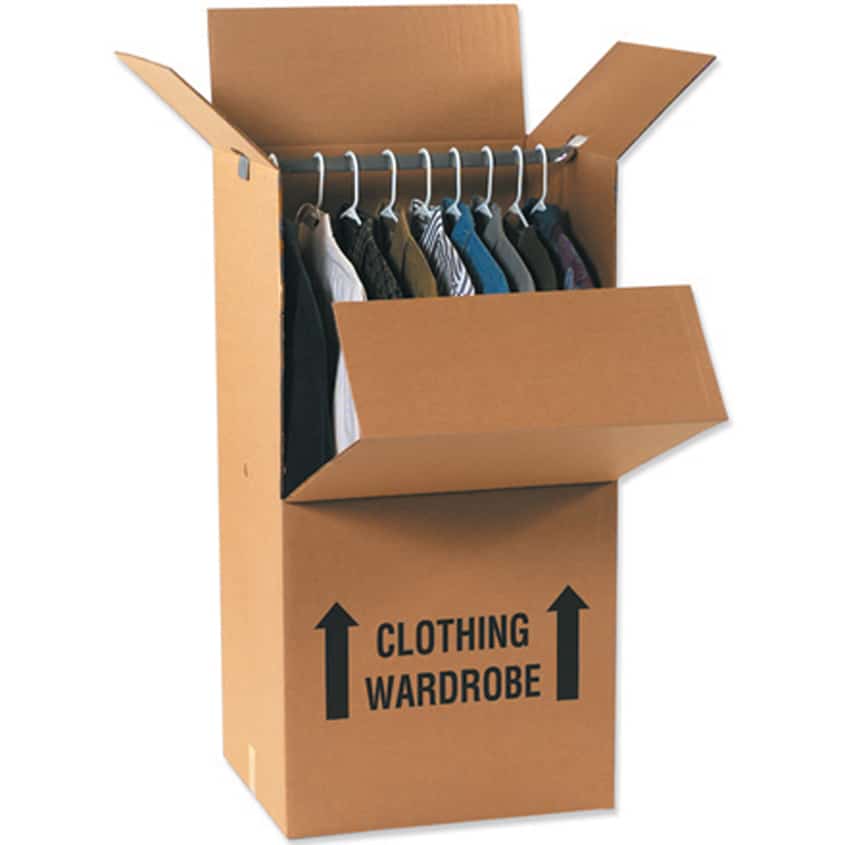
These are tall boxes that have a hanging rack across the top and are great for making sure your hanging clothing doesn’t get wrinkled and are protected from dirt and dust. They’re also easy peasy to use: you simply take hanging clothes out of your closet and hang them from the metal rod in the wardrobe box. Done!
This is the only way to ensure that clothes don’t get wrinkled in transit. They cost more, but if you don’t want to have to iron or dry clean everything, this is the solution we recommend. Carry valuable clothing items in garment bags as well in order to make sure you transport hanging clothes safely.
3. Use Suitcases
If you’re moving suitcases or travel bags to your new house, consider giving them double duty and packing them with clothes. This can also help you easily know where your clothes are on the moving truck. Luggage is also great for more expensive and delicate items.
The major drawback here is that you might want to use some suitcases, such as wheeled ones, for moving larger and heavier items such as books. So you’ll have to really think about what you want to use your luggage for.
Drawstring trash bags are not recommended. The folded clothes inside are only safe if the bag doesn’t rip, which tends to happen. Pack folded clothes in something more sturdy, like vacuum bags.
4. Pack Clothes in Garbage or Vacuum Bags
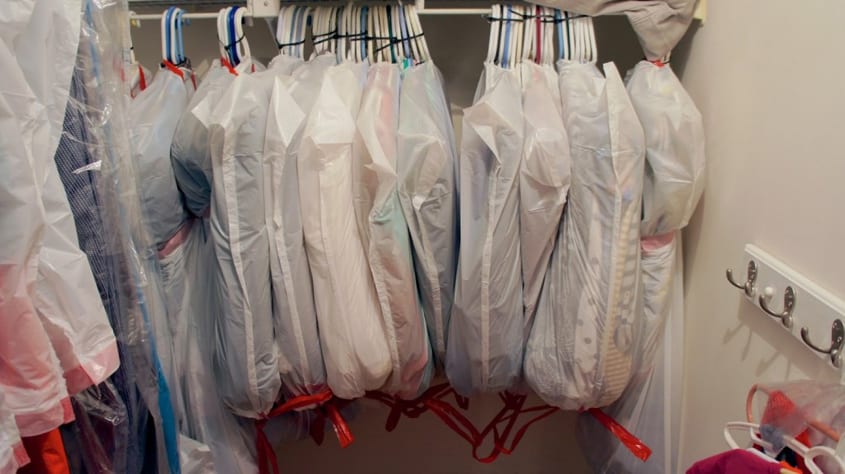
Garbage bags can be used to cover your clothes and keep them from getting dirty. All you have to do is put a hole in the bag’s bottom and pull the hangers with the clothes through the hole. Tie a knot on the bottom and use a twist-tie to keep the hangers together at the top, and, presto!, you’re finished!
Vacuum sealed bags are more efficient because they can hold more clothes. With the air taken out of them, these bags can shrink and take up less space, too. Vacuum sealing is especially useful for out-of-season clothes, because you can put them directly into storage in your new house.
The sad news about garbage and vacuums bags are:
- They rip easily and provide little protection against damage.
- They are slippery, which means it’s hard to put one on top of the other and hold them in place.
5. Wrap Clothes in Plastic or in Sheets
Plastic wraps are just like garbage bags but have the following advantages:
- They aren’t slippery.
- They can be wrapped to the exact length of your hanging clothes
- They can be used to secure and protect clothes in drawers.
- They can be used to tightly wrap the precise amount of clothes you want in them.
Plastic wrap does take some fine-tuning and it’s not the fastest way to pack clothes for moving, but it can be a great solution.
Sheets can be used in the same way, but they don’t offer most of the same benefits. Still, using sheets to wrap clothes is an easy way to pack. Sheets are also easy to carry and aren’t slippery.
To use this method, you spread a sheet on your bed and place layers of clothes on top of it. Start with larger items and work your way to smaller ones. Then, wrap the sheet around the clothes and tie it tightly.
This will help packing folded clothing especially when you’re running low on boxes- but it doesn’t offer much protection from the weather between home and the moving truck.
6. Wrap Breakables in Clothing
Another tip is that you can use your clothes to wrap breakables such as glasses and dishes. This will help you save on the cost of bubble wrap and packing paper. For a little extra snugness, you can pack glasses and stemware in clean, knee-high socks.
We did say to get rid of your old clothing, but you can wrap your breakables in clothes you were planning to throw away. Find clothes that fit the size and shape of what you want to wrap.
Long items fit well in pant legs. For wide plates, wrap them with a shirt. You can also add additional layers of old clothes between items when you start packing them by adding a shirt or extra pair of pants between them.
7. Use Regular Boxes
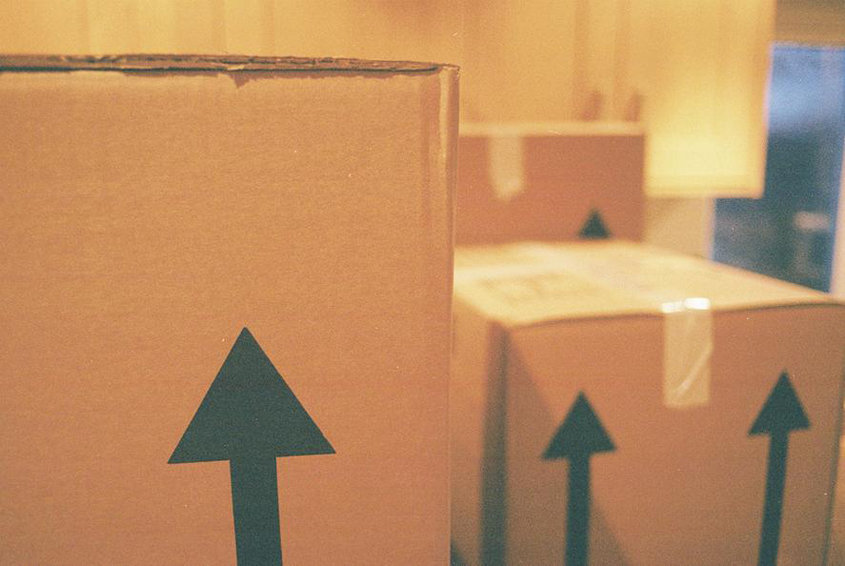
You can use regular cardboard boxes if you think about how you pack, but be sure to label the contents of the boxes properly. Each label should have the following labelled on it:
- Season.
- Size.
- Type of clothes (jackets, sweaters, socks and so on).
- Who it belongs to.
- What room it is going into the new house.
Cover your labels with clear packing tape. This will keep your labels from damage if it rains on your moving day. Write the labels with a dark pen or magic marker so the label’s ink won’t rub off during shipping.
The downside to this method is that clothes might get creased or wrinkled. You can help clothes stay clean by wrapping tissue or packing paper around them.
Be sure to use smaller boxes no larger than 12 by 12 inches because clothes can weigh a lot. If your boxes are too big, the bottoms can collapse and they can be very hard to carry. So lift the box every now and then as you pack. This will tell you when your boxes are getting heavy and when it’s time to use a new box.
8. Pack Shoes Apart from Your Clothing
You can prevent your clothes from getting dirty by packing your shoes separately. Use shoeboxes for the move if you still have them. You can stack shoeboxes into a larger box.
If you don’t have shoeboxes, stuff your shoes with socks or paper so they won’t get crushed and still keep their form during the move. It’ll also prevent scuffing. You can also save space by alternating the position of your shoes.
9. Pack Your Hats Separately
Categorize your hats by brim style and size, and group them into sets of 6. Lay a sheet of tissue paper between each hat and stack them. Take as much space as you need. Be careful not to stuff or jam them into your box or you risk permanently crushing or bending the shape of the hat permanently.
More Tips for Packing Your Clothing
There are a few other things to keep in mind as you pack that will help keep clothes organized when moving and prevent damage:
- Don’t put jewelry with clothing. You risk snagging or tearing your clothes if you do.
- For delicate clothing, separate them with cloths or layers of paper towels.
- Always place heavy items at the bottom of your boxes and lighter items on top.
- If your clothes are going to be packed away for a long time, such as winter clothes, consider spraying them with clothing-specific insect repellent. This will prevent ants and spiders from making a home in your favourite items.
Need more tips on packing other items in your home? We have a great collection of packing tips articles.
Get Moving With Cassidy’s!
We know your moving checklist is long, and preparing for a move can be stressful. Take a few things off that long list by calling Ottawa’s most reliable movers! The professional team at Cassidy’s can make your moving day a breeze. We’ll move you anywhere in Ottawa Valley, Across Canada or Around the World with professionalism, care, and personality!

